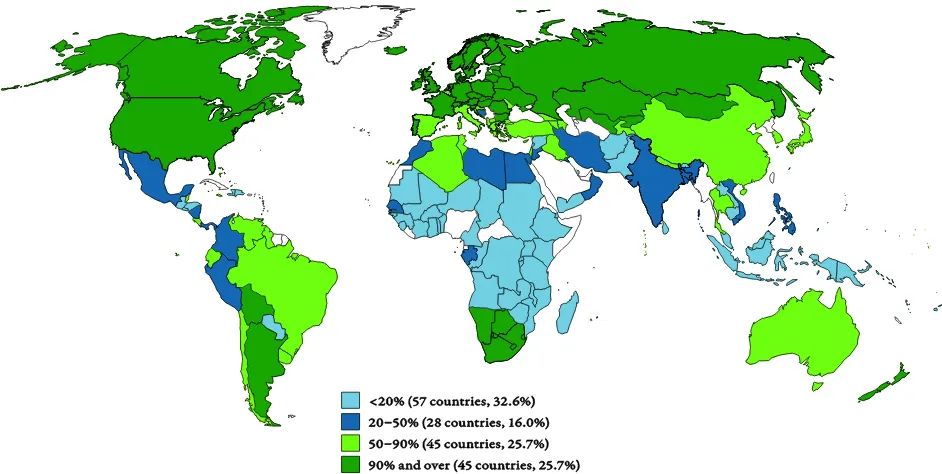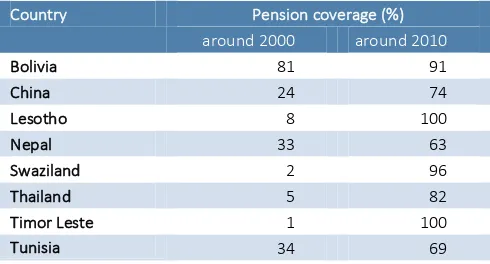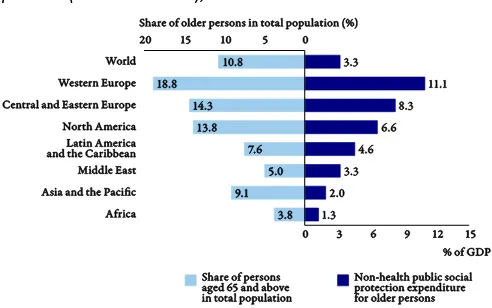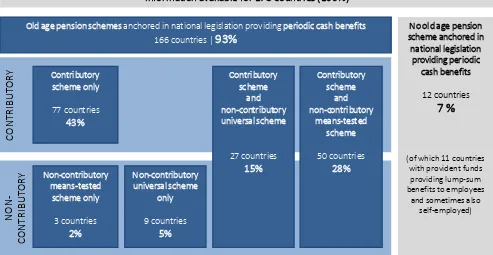Pe sio s a d other so ial prote tio
e efits for older perso s:
I sights fro the ILO World “o ial Prote tio Report
/
Social Protection for All Policy Brief No. 3/2014
Public social security pensions are essential tools for ensuring income security for women and men as they grow older. This income, along with access to quality health services, is necessary for the dignity and well-being of older persons, and imperative to realize their rights (see Box 1).
The state of old-age pensions worldwide
Nearly half (48 per cent) of all people over pensionable age do not receive a pension. For those who do, the income provided is often inadequate to keep them from living in or falling into poverty. As a result, the majority of the orld’s older o e a d e must continue working for as long as they physically can, often poorly paid and in precarious conditions.
There are considerable disparities among regions (see Figure 1). In Europe, statutory and effective coverage of public pensions is relatively high. Meanwhile, in many middle and low income countries, pension coverage is significantly lower.
Where sizeable informal sectors exist, the collection of contributions or tax payments to finance public
Key points
Old age pensions and other social protection benefits are key to ensuring income security and well-being for older persons.
Nearly half (48 per cent) of all people over pensionable age do not receive a pension.
This gap will have to be filled to a large extent by an expansion of non-contributory pensionsso ial pe sio s .
Many countries have recently made efforts to expand the coverage of contributory pension schemes and to establish non-contributory pensions to guarantee at least basic income security in old age to all.
Yet, at the same time, fiscal consolidation processes are creating global pressure to reduce state responsibility for guaranteeing income security in old age and shifting large parts of the economic risks associated with pension provision onto individuals, thereby undermining the adequacy of pension systems and reducing their ability to prevent poverty in old age.Figure 1: Old-age pension beneficiaries as a proportion of the population above statutory pensionable age, 2010-12 (percentages)
2 Social Protection for All Policy Brief No. 3
Box 1: International standards on old-age pensions
Universal Declaration of Human Rights (1948) and International Covenant on Economic, Social and Cultural Rights (1966) both enshrine rights of older persons to social security and to an adequate standard of living to support their health and well-being, including medical care and social services.
The ILO Social Security (Minimum Standards) Convention, 1952 (No. 102) and Old-Age, Invalidity a d “ur i ors’ Be efits Co e tio , 1967 (No. 128) set out an international framework for the range and levels of social security benefits necessary for ensuring income security and well-being of older people..
The ILO Social Protection Floors Recommendation, 2012 (No. 202) completes this framework by calling for a guarantee of at least basic income security to all persons in old age, as well as access to essential health care, as part of nationally-defined social protection floors.
pension systems is difficult. The result is often significantly lower coverage of workers in the informal economy: the introduction of non-contributory schemes can help to close the gaps.
Even where pension coverage is high, the adequacyof pension benefits remains a challenge. Many older persons receive low pensions which do not allow them to make ends meet. Ensuring adequate pension levels, in many cases through non-contri-butory and contrinon-contri-butory pensions combined, including adequate indexation mechanisms, is key to guaranteeing income security for older persons.
A gender gap in pension coverage mirrors the inequalities faced by women in the labour market and employment. Women’s eligi ility a d e efits are constrained by their lower labour force partici-pation, lower average earnings, higher incidence of informal employment, and more frequently inter-rupted periods of employment due to an unequal distribution of family care work.
Recent expansion of pension coverage
Persistent gaps in coverage are associated with high levels of informal employment in many low and middle income countries. The large majority of workers in the informal economy will face income insecurity in old age, unless sufficient efforts are made to extend coverage through non-contributory pension schemes, and/or through the extension of contribu-tory schemes to previously uncovered groups of wor-kers, including the disproportionate share of women workers in informal employment.
Recently, there has beensignificant progress made in some countries through the creation or expansion of non-contributory pension schemes that provide at least a basic level of protection (e.g. Bolivia, Lesotho, Nepal, Swaziland, Timor Leste). Other countries (e.g. China, Thailand, Tunisia) have expanded contributory
schemes to previously uncovered groups of the population, in combination with an extension of non-contributory pensions (see Table 1).
While this extension of coverage represents significant progress, benefit levels are often modest. Ensuring the adequacy of pensions remains a considerable challenge, particularly as some countries seek to find cost savings in public pension schemes as part of fiscal consolidation measures in the wake of the global crisis.
Public expenditure on pensions and other benefits
for older persons
Globally, more than half of total public non-health social security expenditure, amounting to 3.3 per cent of global GDP, is allocated to income security for older persons (see Figure 2).
Public non-health social protection expenditure for older persons takes the highest proportion of GDP in Western Europe, at 11.1 per cent, followed by 8.3 per cent of GDP in Central and Eastern Europe and 6.6 per cent in North America, yet accounts for only 1.3 per cent of GDP in Africa, where the share of older persons in the total population is significantly lower. In Latin America and the Middle East, 4.6 per cent and 2.0 per cent of GDP respectively is allocated to the income security needs of older persons, while in Asia and the Pacific, where the share of the older population is significantly higher, only 2.0 per cent of GDP is allocated to the older population.
Table 1: Increase in pension coverage, 2000-2010
Country Pension coverage (%)
around 2000 around 2010 Bolivia 81 91
Social Protection for All Policy Brief No. 3 3
Box 2: Re-refor s a d the u pri atizatio of pe sio syste s
Between 1981 and 2008, 11 Latin American countries completely or partially privatized their public pay-as-you-go pension schemes. These reforms spread to Central and Eastern Europe in the 1990s and early 2000s, where an often significant share of social security contributions were channeled into mandatory, privately managed individual accounts.
I Chile, here this e paradig as i trodu ed i , it e a e lear that the e syste had failed to enhance coverage and compliance as expected, incurred high fiscal cost (at one point as high as 7.6 per cent of Chilean GDP), and was unable to ensure adequate income security in old age. Chile was, thus, the first country to initiate re-reforms, and several schemes were introduced in 2008 that added a dimension of public provision (for lower income groups) and greater supervision of the private pillar. Uruguay initiated similar re-reforms in 2013, while other countries like Argentina (2008) and Bolivia (2010) eliminated their private pension pillars completely, making all pensions publically provided.
Full or partial renationalizations have also occurred in Hungary, Kazakhstan, Poland, Lithuania and Russia.
Reforming and re-reforming pension systems
Fiscal consolidation policies in more than 120 countries are leading to adjustments in public services. Approximately 86 governments in 47 developing and 39 high-income countries have been considering changes to their pension systems, including:
Raising the pensionable age
Making eligibility conditions stricter
Lowering replacement rates
Eliminating minimum guarantees
Stopping indexation to wages and/or prices
These adjustments are undermining the adequacy of pension systems and reducing their ability to prevent poverty in old age. It is alarming that future pensioners will receive lower pensions in at least 14 countries of Europe. Ill-designed pension reforms have endangered
the balance between adequacy and sustainability. Claims of a social se urity risis or old-age risis have been used as justification to introduce reforms, some of which substantially reduce the future adequacy of benefits.
As governments struggle to create attractive invest-ment environinvest-ments, pressures from tax competition and global financial markets limit their sovereign power to ensure adequate levels of social security contributions and taxes necessary to prevent benefit cuts.
However, it must be noted the trend to reverse the large-scale privatizations of social security pensions started the 1980s, in theory introduced to further ease the burden on public finances. In recent years, a significant number of countries have reversed the earlier privatizations, re-nationalizing fully or partially their pensions systems after poor performance (see Box 2).
A policy mix for universal coverage, anchored
in rights
The strong positive impacts of social protection have brought the expansion of old-age pensions to the forefront of the development agenda. Social protection is a key element of national strategies to promote human development, political stability and inclusive growth. Most middle-income countries are boldly expanding their social protection systems, thereby contributing to their domestic demand-led growth strategies: this presents a powerful development lesson. China, for instance, has achieved nearly universal coverage of pensions and increased wages.
Figure 2: Public social protection expenditure on older persons (without health), 2010-11
4 Social Protection for All Policy Brief No. 3
ILO World Social Protection Report 2014/15
This policy brief is based on the ILO World Social Protection Report 2014/15: Building economic recovery, inclusive development and social justice (ILO, 2014).
For more information please refer to this report, available at: www.social-protection.org
Around the world, many national pension systems combine contributory and non-contributory schemes, anchored in national legislation in order to ensure universal coverage and adequacy (see Figure 3). Non-contributory benefits usually provide a basic level of income security in old age, thereby reducing or preventing poverty. Public pension schemes financed from contributions typically provide higher benefits that ensure income security for large groups of the population, including the middle class.
The overwhelming majority of countries have created their social security systems through acts of
legislation, thereby protecting benefits from pressures that may result from a change in political leadership or external shock. National laws often turn social security benefits into entitlements, which provide a legal right to social security.
Ensuring the extension of coverage, adequate benefit levels, as well as sustainable and equitable financing are crucial to providing older persons the security they need and, indeed, are entitled to.
Figure 3: Overview of old-age pension schemes anchored in national legislation, by type of scheme, 2012/13
Sources: ILO World Social Protection Report 2014/15, Figure 4.3. See there for detailed sources.
Old age pension schemes anchored in national legislation providing periodic cash benefits
166 countries |
93%
Information available for 178 countries (100%)
Contributory
The editor of the series is Isabel Ortiz, Director of the Social Protection Department, International Labour Organization (ILO). For more information, contact: ortizi@ilo.org.



